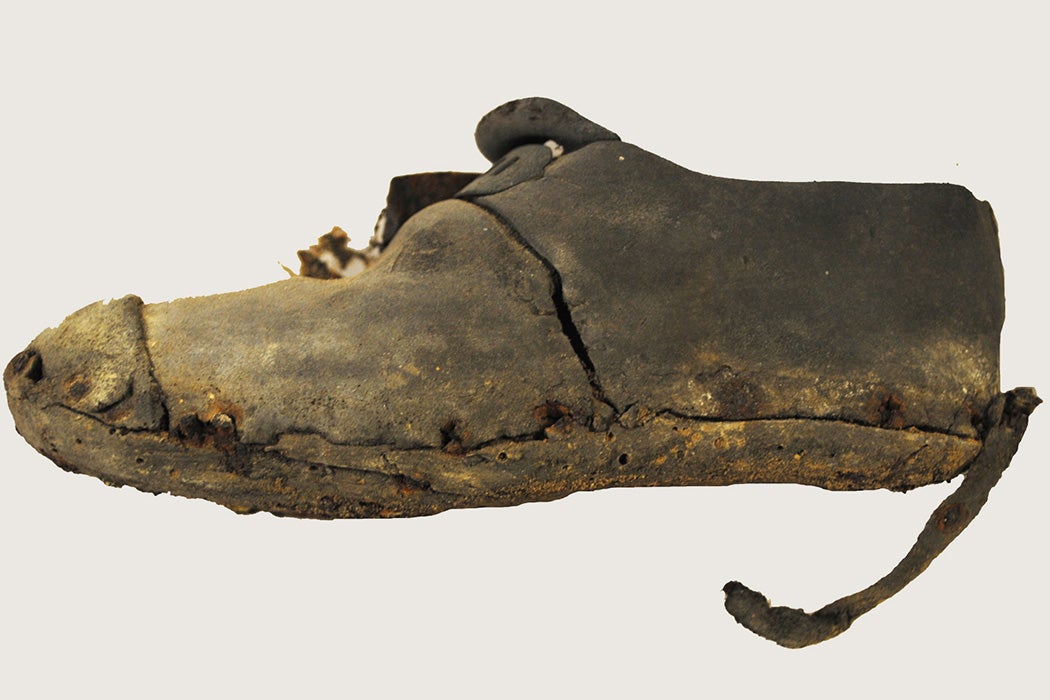If you live in an old house, there may be more than you realize behind its walls or under its floors. For centuries, there was a custom in Great Britain (which spread to Britain’s colonies in the Americas) of ritual concealment, placing objects in different parts of the house as totems. The practice seems to have been widespread in Britain from the medieval period into the twentieth century. Often, the concealed object was a shoe. The oldest such hidden shoe was found at Winchester Cathedral and dated to 1308.
According to researcher Jessica Costello, cases of hidden shoes also “abound” in New England. John Adams Birthplace, a house built by Joseph Penniman in 1681, contained an incredible forty-four shoes and boots, discovered during restoration of the house in the 1980s.
But why were shoes so significant? Scholars suggest a number of different theories. Shoes have had a significant role in Western folklore, and according to Costello, they feature in various superstitions both hopeful (finding romance) and frightening (warding off death). For instance, there was a well-known tale of English rector John Schorn, who was supposed to have trapped the devil in a boot in 1300. Schorn himself attracted a cult following for his devil-defeat, and this may explain why a shoe was once thought to be a trap for an evil spirit or able to ward off evil.
Throwing shoes after people was also meant to be good luck, writes Costello, something that evolved in the twentieth century to shoes being tied behind the car of a newly married couple. Our sentiments about shoes are expressed in different ways today (parents keeping, or even preserving, their baby’s first shoes, for example), but the hidden shoes that can be discovered in an old building can tell us much about the people who hid them.
Unlike the shoes that are preserved in costume collections, which tend to be those kept because they were of high value or represented a significant event (wedding shoes), those used in ritual concealment are typically everyday shoes. As Costello notes, the commonness of the footwear
may explain why concealed shoes are sometimes discarded upon discovery. To someone unfamiliar with ritual concealments, these shoes may simply look like rubbish. In reality, these tattered, humble specimens are significant finds, ritually infused artifacts that can help scholars better understand the people who concealed them.
There are a number of different interpretations of shoe’s intended role to be in protection. Perhaps it was to placate a spirit as a token gift or to serve as a spirit trap (see also: catching the devil). There’s also the issue of who did the concealing, with some theorizing it wasn’t necessarily householders, but builders seeking protection for their work. According to Costello, oral histories also suggest that some concealed shoes belonging to a deceased loved one in order to keep their spirit close.
Shoes, however, weren’t the only things tucked away in wall. Cultural heritage management scholar M. Chris Manning outlines the wide range of objects found hidden in houses. There were items deliberately to ward off magic, like witch bottles, which Manning argues “demonstrate the persistence of magical traditions among Americans of European descent.” So-called witch bottles were filled with objects personal to the owner, including human hair, fingernail clippings, metal pins, and often urine (!), after which they would be sealed and placed somewhere in a house. As anthropologist M. J. Becker describes in Archaeology magazine, the bottles were designed to trap a witch or at least deflect her spells.
Weekly Newsletter
Dead cats were also commonly placed in the walls or hidden in the roof space, sometimes even posed with dead mice or rats. This seems to have been widespread in Europe and adopted in parts of the US into the late nineteenth century. The role of the cat was perhaps to scare rodents (symbolically if not literally) or as a general charm for good fortune. Other items used in this way have included horse skulls, iron objects, and poppets (small dolls). The Concealed Reveal, a research project in England, has catalogued formerly concealed objects now held in different collections
Records of such curiosities are necessarily incomplete because some of the hidden objects won’t have been recognized as significant but regarded as random detritus when a building is renovated or demolished. Concealed clothing, for example, can just appear to be rags. A cat skeleton may just be assumed a result of feline misfortune, not a deliberate act of preservation. So look carefully, if you’re replacing an old chimney breast or adding that new kitchen in your historic house. You may discover that previous residents have left you a lucky charm.
Support JSTOR Daily! Join our membership program on Patreon today.







